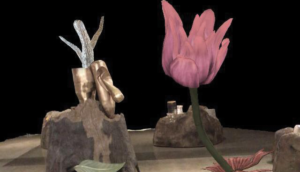Glass-sculpted tree trunks with bright, painted tree rings on gray rock formations fill a small exhibition room at the Renwick Gallery. Without the aid of the exhibit’s app, the room seems barren and as a whole underwhelming. The magic of the exhibit, however, lies in its use of augmented reality technology to populate the room with lush, imaginative plants, challenging the limits inherent in physical art installations.
The exhibit, titled “Reforestation of the Imagination” opened in late June and runs until January 5, 2020, represents the latest development in Seattle-based glass artist Ginny Ruffner’s expansive career. The exhibit combines her meticulous attention to detail with lush flora and fauna that only sprout up when digitally summoned by viewing the exhibit through a tablet or smartphone screen.
AR technology relies on a visitor looking through their cellphone or museum-provided tablet to read specific patterns that then tells the device to render the plants on the screen through an app, and Ruffner has ingeniously painted these patterns into the tree rings that decorate the stumps.
Both the gray tones of the stone platforms and the crystallized glass stumps make the exhibit initially feel bleak and desolate; the room seems to have space for vibrant life until the visitors pass over each stump with a smartphone camera.
The clear glass stumps paired with the warm and organic colors of the tree rings visually indicate the main tension present throughout the exhibit: the natural world intersecting with and at times becoming part of the manufactured world.
Similarly, the 3D-modeled and digitally colored flora of Ruffner’s digital botanical garden are themselves fusions of the natural with the fabricated, seen especially in the plants the artist imagined with names such as pyrus fenestrata, or “pear with windows,” a pear with literal windows bore into its sides. The artist named every plant similarly, following Latin naming conventions to flesh out her reimagined natural world.

Ruffner designed each AR plant, and prototypical sketches hang around the room and were compiled in a book that documents each plant’s name, tree ring pattern and 3D rendering. The exhibit showcases not only Ruffner’s technical skill with glasswork, but also her dedication to worldbuilding and creativity even in such a relatively small exhibit.
While examining each plant through the freeing lens of AR, the plants shed the limiting possibilities that would have constrained them if they had just been carved from glass. In a charming example of Ruffner’s creativity, one tall flower slowly blows a bubble that rises across the screen at disappears at its edge as the stem and leaves of the plant undulate slowly and consistently.
In contrast to the monotone physical staging pieces of the exhibit, the digital plants, rendered in part by Seattle animator Grant Kirkpatrick, feature vibrant colors and lush leaves. Some even have textures overlaid on the flowers, giving the plants an otherworldly and alien feel.
In moments like these, the novelty of the exhibit and potential for artistic innovation become clear. By playing with the natural and the artificial, the tangible and the digital, Ruffner creates a visually striking and engaging exhibit that builds upon her glasswork career rather than overshadowing it.
In the same vein, however, the limits of the technology itself make up the exhibit’s weakest moments. The tree ring codes prove finicky to capture in just the right light and from just the correct distance in order to get the digital plants to appear. Even once a plant manifests on the stump, the AR sometimes gets stuck recalibrating, making the plant jump around the screen unintentionally.
Additionally, each tree ring only makes one plant appear. Even though the plant’s designs are intriguing and eye-catching, the one plant per tree ring code setup still leaves the installation feeling slightly sparse.
Despite these technological limitations, the mere premise and innovation of the exhibit makes it worth a visit to the Renwick Gallery. Ruffner clearly crafted each plant with thoughtfulness, and she offers an exhibit that highlights the complexity and beauty of showcasing the natural world through a digital lens.
The use of AR pushes the exhibit to occupy a daring space in art where installations no longer have to comply with the physical limits of their mediums; opening art to interact with the digital sphere fundamentally changes the potential of art exhibits by expanding the definition of what is possible for artists.



















